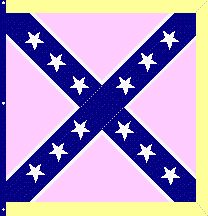 Army of Northern Virginia Battle Flag Silk Issue (Second Type), 1861 By Devereaux D. Cannon, Jr. 27 January 2000 from a sketch by Howard M. Madaus |
 Battle Flag of the Department of Alabama, Mississippi and East Louisiana, 1863-65 By Devereaux D. Cannon, Jr. 27 January 2000 from a sketch by Howard M. Madaus |
My question is: Why on some Southern Cross Battle Flags is the
center or thirteenth star omited. Did it have anything to do with
someone being upset with one of the States that were supposed
to join the Confederacy, and if so what was the problem.
Thank you for your time, Jerry
The first part comes down to time frame. The first issues of the battle flag of the Army of The Potomac (later renamed the Army of Northern Virginia) were distributed to the troops in late November/early December 1861. By that time 11 states had seceeded and the de facto secession of Missiouri had been recognized by the Confederate Congress – hence 12 stars.
Kentucky’s secession was not recognized until later in December, 1861.
Yet – despite this, the first cotton ANV flags that were issued in April/May, 1862 still only had 12 stars. The first wool bunting issues that came out in June finally added the 13th star.
The flags that came from Mobile, Alabama under contract by James Cameron and (mostly) Jackson Belknap starting in late 1863 and on into 1864 were only 12 star battle flags. I had thought that the makers may have been upset with Kentucky as it was Abraham Lincoln’s birthplace – but flags historian Howard Madaus thinks (probably correctly) that it had more to do with the fact that the original 12 star HQ flag for the 5th Company, Washington Artillery of New Orleans had been sent to Mobile for safe keeping during the war – and it only had 12 stars! It was probably the pattern for the flags that Cameron/Belknap produced – although their’s were rectangular and lacked color exterior borders.
Greg Biggs, 5 January 2000